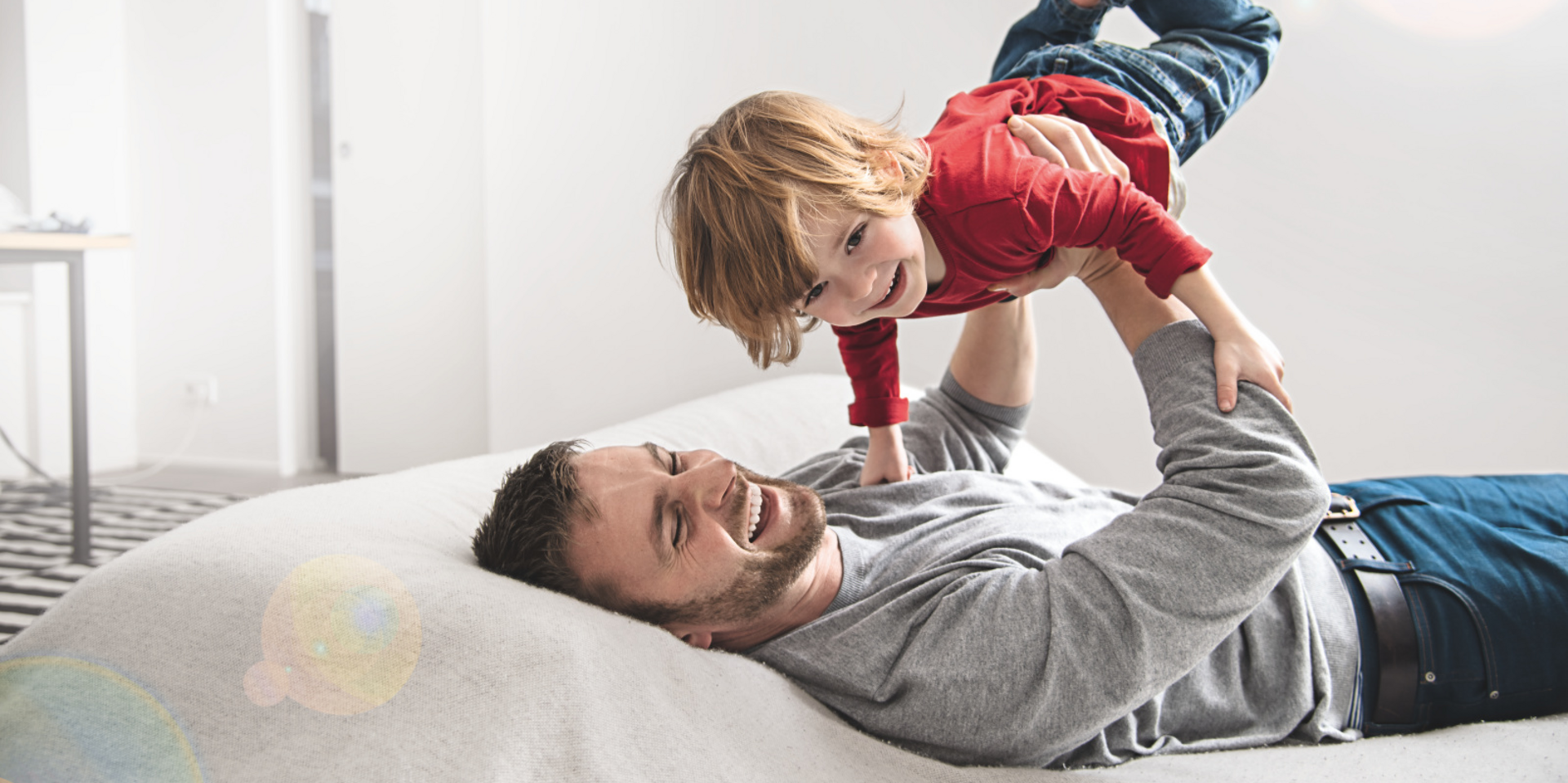
Pure comfort with maximum hygiene
Zehnder sets high standards, not just for fresh air: Zehnder also develops products and services that guarantee comfortable room ventilation and that always function optimally and hygienically.
Tips and information on operation and maintenance:
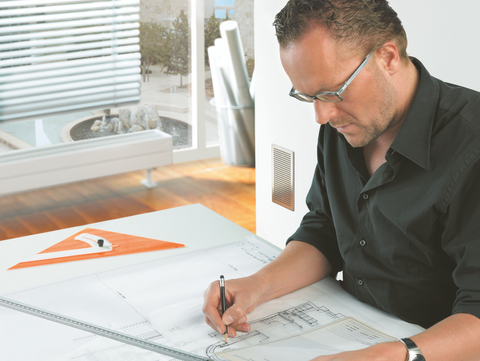
Installation tips and information:
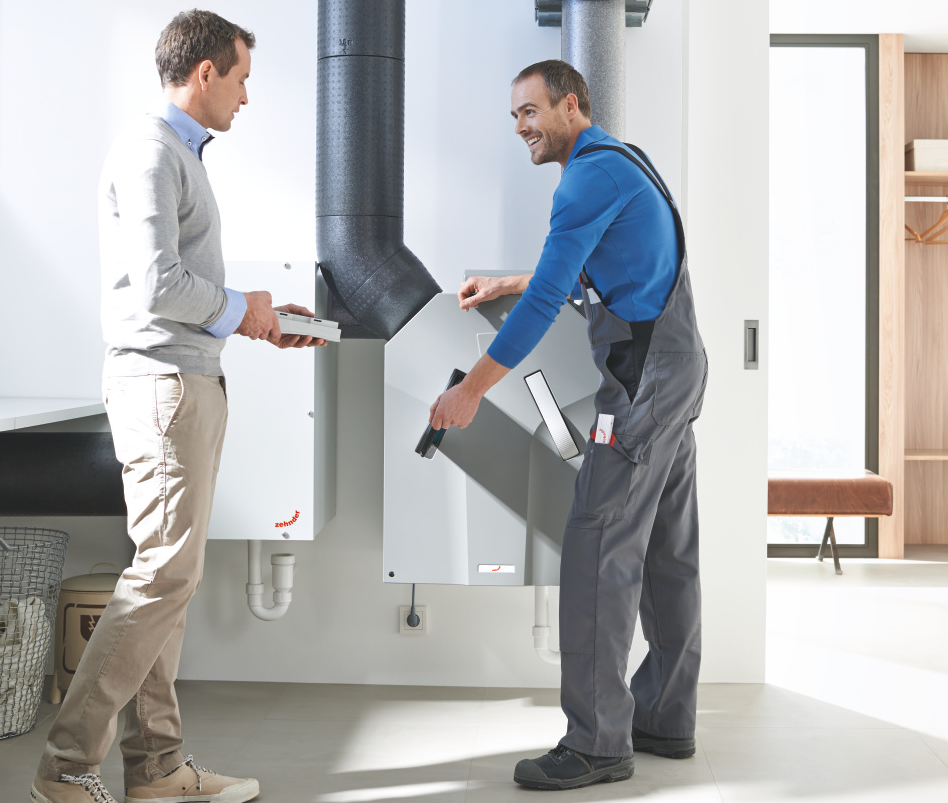
Tips and information on operation and maintenance
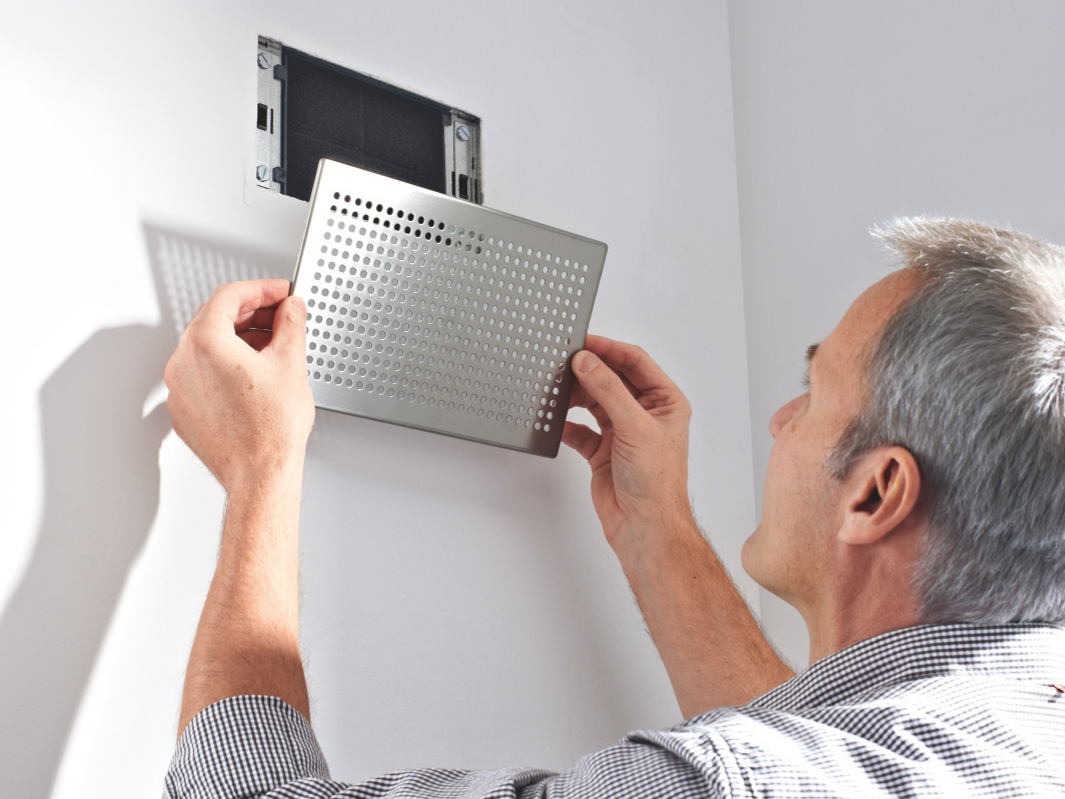

These hoods should be planned so that they are easily accessible at all times.
The intake and exhaust hoods can be provided either in an external wall or in the roof. It is important that they are provided in areas where external influences cannot affect the quality of the intake air (e.g. flue gases, waste containers, etc.). The exhaust, which may contain unpleasant odours (e.g. from the kitchen), should be provided in a place where it cannot cause a nuisance. For example, it is not desirable to blow out the exhaust air on a balcony. Also, the supply and return hood should be installed sufficiently far apart. In practice, spacing of more than 3 metres or positioning on two sides of a corner appear to be suitable solutions. The prevailing wind direction also plays a decisive role here.
For optimal hygienic operation, the system should be easily maintained.
The user only needs to follow some simple aspects of maintenance and perform "minor maintenance". This involves the user checking the filter every three months and replacing it if necessary. Every six months, the filters should be replaced. Original replacement filters can be purchased through the installer or simply through the Zehnder online shop. The system should also be checked - at greater intervals - periodically by the professional. (major maintenance) People with allergies can also rejoice: the optional pollen filters also capture fine dust and pollen, allowing people with allergies to breathe with relief. These filters can be easily retrofitted and are also available from the installer or the online shop. Should the comfort ventilation system become soiled contrary to expectations, e.g. through careless use, it can be easily cleaned by the installer.
Tips and information on operation and maintenance
In addition to a socket and air vents, a water drain must be present in the installation room, as condensation water may be released into the Zehnder ComfoAir ventilation unit during the year. This demonstrates a particularly efficient operation of the ventilation system. The condensate connection ensures that any sewage gases and unpleasant odours do not enter the ventilation system. The condensate water is collected and drained directly from the Zehnder ComfoAir ventilation unit via the condensate drain.
The position of the exhaust valve in the kitchen should be placed at a sufficient distance from the cooker. Keep in mind that the inlet and outlet in the kitchen serve as a permanent air change and not as an ordinary cooker hood. Lateral distances of min.1.5 metres from the cooker appear to be sufficient.
Maintenance space should therefore be provided around the distribution box. Both the intake and exhaust covers and the supply and exhaust valves should be easily accessible. In addition, there should be space for maintenance in front of or below the ventilation unit.
In general, all supply and return ducts should be installed within the protected volume of the building. This will prevent condensation formation and energy losses and keep the ducts in an immaculate, hygienic condition at all times.
Scheduling an installation in non-protected volume is not recommended by Zehnder.
The Zehnder ComfoPipe Plus with only 43 mm insulation thickness meets the standards for proper insulation.
Through a "forced" air flow in the room, harmful substances such as CO2, VOCs, gases, excessive humidity and unpleasant odours are optimally removed from the room and building. Thus, rooms are permanently supplied with fresh, clean air.
Generally, the supply valves in the room should be positioned diagonally to the exhaust valves (usually the area below the doors).
When using high inducing supply valves (Zehnder saucer valves, Zehnder renovation valves), the opening can also be positioned closer to the return valve.
When planning a construction project, sufficient time must be allowed for the drying of the shell of the building. Using ventilation during the construction phase creates a risk of contaminants in the ventilation system. Ideally, the system should be commissioned only when the occupants move in.
If the installation is below ground level, it is recommended to provide the suction hood min.1m above ground level, for maximum hygiene.
Installations with a Zehnder ComfoWell Filter Box:
For installations with a ComfoWell Filter Box, the standard G4 class filter remains present in the Zehnder ComfoAir ventilation unit, even when an additional pollen filter is fitted. The pollen filter is placed in the filter box. This pollen filter box is installed in the air supply (duct between unit and the distribution box for the supply air). Thanks to the modular construction of Zehnder ComfoWell, the filter box can also be installed directly in front of the distribution box.
Installations with a ground heat exchanger Zehnder ComfoFond-L:
In installations with a Zehnder ComfoFond-L ground heat exchanger, the coarse dust filter (G4) from the appliance can be inserted directly into the Zehnder ComfoFond-L. The pollen filter can then be placed in the vacant position in the appliance.
The first siphon, the dry siphon, separates the return air side of the ventilation unit from the installation room. We recommend the dry Zehnder siphon for this, as there are also periods when no condensation water is released and the water could then evaporate.
The second siphon, a funnel siphon, is connected to it via a free outlet of min. 40 mm. This closes off the outlet in relation to the installation room. This feature also eliminates lower heat recovery due to false air.
A filter can be placed in the drain valve in the kitchen. This ensures that the air ducts always remain hygienically clean and free of grease, reducing maintenance.
The filters can easily be placed in the openings.
Maintenance space should therefore be provided around the distribution box. Both the intake and exhaust covers and the supply and exhaust valves should be easily accessible. In addition, there should be space for maintenance in front of or below the ventilation unit.
In general, all supply and return ducts should be installed within the protected volume of the building. This will prevent condensation formation and energy losses and keep the ducts in an immaculate, hygienic condition at all times.
Scheduling an installation in non-protected volume is not recommended by Zehnder.
It is recommended to use vapour permeable insulation or a pipe system that meets this standard, e.g. Zehnder ComfoPipe and Zehnder ComfoPipe Plus.
When using a pipe system that does not meet these requirements, additional insulation should be fitted. When using an insulation layer based on mineral fibre, care must be taken to ensure permanently tight bonding of butt joints and connections.
Through a "forced" air flow in the room, harmful substances such as CO2, VOCs, gases, excessive humidity and unpleasant odours are optimally removed from the room and building. Thus, rooms are permanently supplied with fresh, clean air.
Generally, the supply valves in the room should be positioned diagonally to the exhaust valves (usually the area below the doors).
When using high inducing supply valves (Zehnder saucer valves, Zehnder renovation valves), the opening can also be positioned closer to the return valve.
To avoid additional cleaning, contamination in the pipes should be avoided during the construction phase. Ideally, the system should only be commissioned when the occupants move in.
All components are delivered in sealed packaging so that no dirt can enter the components during the transport and storage phase. This should remain so throughout the construction phase. Zehnder also provides sufficient suction and discharge caps, so that Zehnder components meet very high hygiene requirements from the outset.
Commissioning is done with a suitable instrument for volumetric flow measurement and takes approx. 2-3 hours incl. device adjustment. Measurement takes place at the supply and exhaust valve each time using a so-called rotor anemometer or a back-pressure gauge with a funnel. The adjustment of the ventilation system creates a balance between supply and return air quantities in various ventilation levels. In addition, during the adjustment of the individual valves, the hygienically required air flow rate is set according to the reason for use and room occupancy.
To ensure optimal operation of the system even after a longer period of time, we recommend the conclusion of a maintenance contract. The maintenance works are divided into some easy-to-perform works that the end customer or user of the installation can carry out himself (minor maintenance*) and works that must be carried out by a professional installer (major maintenance*).
If these are carried out correctly and at the specified intervals, your customer's system will always function immaculately and hygienically. To this end, offer your customer a maintenance contract.
The intake and exhaust hoods, the supply and exhaust valves and the Zehnder ComfoAir ventilation unit must be easily accessible for filter replacement.
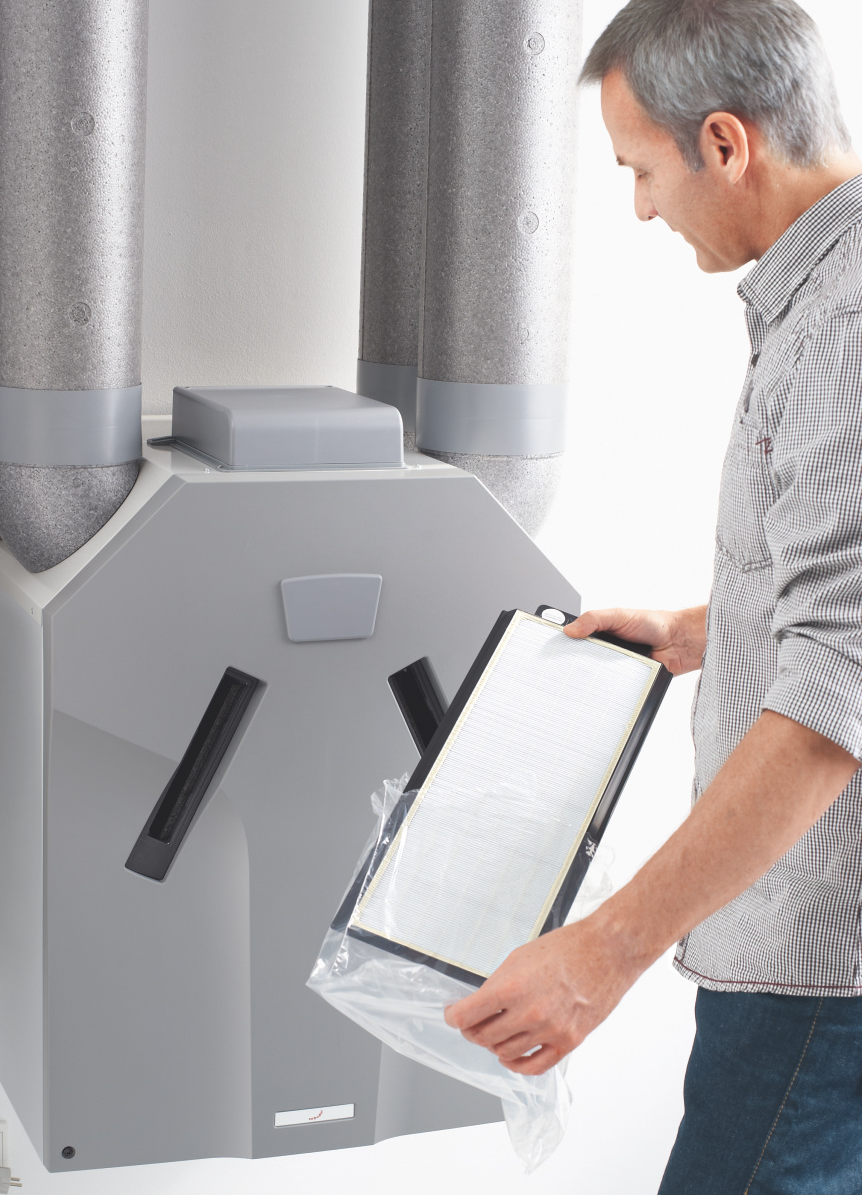
In a few steps, a skilled installer can carry out major maintenance* to ensure energy-efficient and hygienic operation of the comfort ventilation system. Therefore, offer your customer a maintenance contract.
Major maintenance*:
Minor maintenance*:
In practice, it has been proven that every 3 months is best. Checking does not mean that filters should be replaced immediately. This strongly depends on the location of the installation and where the outdoor air intake is located. In general: In a city, the pollution potential is generally higher than in the countryside, and in a newly built area, the load is heavier than in a neighbourhood that has been around for some time. Zehnder generally recommends changing filters at least once a year, regardless of the level of pollution.
Can the filters be vacuumed?
The filters can be cleaned of dirt superficially by a hand hoover. However, deeper penetrated, stuck-on dirt cannot be removed this way. This 'storage effect' of the filter enables a measured service life. Zehnder recommends replacing the filters at least once a year, regardless of the degree of soiling.
Can the filters be washed?
Zehnder advises users not to wash the filters. Superficial dirt is removed, but deeper penetrated dirt actually penetrates even further into the material. A clogging of the filter is the result. Depending on the degree of soiling, mould growth may also occur due to too low airflow and sponge action.
Where can users buy filters?
As an installer, offer your customers the supply of appropriate original filters. In addition, your customer has the option of ordering the filters in the Zehnder Filter Shop.
The drain covers should always remain accessible, as they should be checked for contamination every two years and cleaned if necessary. As the installer, make the user aware of this.
To ensure optimal and hygienic operation, the user should check the filters every three months and replace them after six months at the latest (minor maintenance*). If there are persons with allergies, you may recommend using low-cost pollen filters instead of the standard coarse dust filters.
As an installer, ask about it and point out the maintenance to your customers and offer them the appropriate original filters. You can also refer your customers to the Zehnder online shop to purchase replacement filters.
The dry siphon acts as an odour trap between the Zehnder ventilation system and the sewer system. During major maintenance*, the installer checks it every two years for leaks, operation and cleans it if necessary.
Through the exhaust valves, moist, consumed air, kitchen odours, tobacco smoke and volatile organic compounds (VOCs) are continuously expelled.
Therefore, its filters should be replaced every six months. As an installer, offer your customers the supply of the appropriate original filters or refer them to the Zehnder online shop.
All relevant components of Zehnder ventilation systems are equipped with necessary maintenance openings to ensure hygienic immaculate and easy maintenance.
To rule out possible damage to the insulation layer, a visual inspection should be carried out.
When using ventilation during the construction phase, there is a high risk of heavy contamination of the components. This results in greater cleaning efforts even before it can be used at all. Zehnder recommends commissioning the installation only shortly before commissioning and handover to the user.
Because Zehnder components are packed airtight on delivery, maximum hygiene and cleanliness of the system can be guaranteed during the entire construction phase, if the installation is only put into operation after all construction work has been completed.
Commissioning the comfort ventilation system also includes handover. As a professional, explain the most important functions to your customer and point out the necessary maintenance work.
The comfort ventilation system removes residual moisture and pollutants from the building. The permanent flow of components thereby keeps the ventilation system hygienically clean. In general, the ventilation system should always remain in operation to ensure hygiene at all times. Instead of switching off the system completely, it is better to adjust the air flow rates to current requirements via a time programme of the control unit or by manually selecting the ventilation levels.
Which air quantity is the right one in case of prolonged absence? Generally, in such cases, the lowest ventilation level is suitable to keep the indoor climate permanently comfortable and meet all hygiene requirements. Incidentally, the energy consumption is so low that it is de facto negligible.

These hoods should be planned so that they are easily accessible at all times.
The intake and exhaust hoods can be provided either in an external wall or in the roof. It is important that they are provided in areas where external influences cannot affect the quality of the intake air (e.g. flue gases, waste containers, etc.). The exhaust, which may contain unpleasant odours (e.g. from the kitchen), should be provided in a place where it cannot cause a nuisance. For example, it is not desirable to blow out the exhaust air on a balcony. Also, the supply and return hood should be installed sufficiently far apart. In practice, spacing of more than 3 metres or positioning on two sides of a corner appear to be suitable solutions. The prevailing wind direction also plays a decisive role here.
For optimal hygienic operation, the system should be easily maintained.
The user only needs to follow some simple aspects of maintenance and perform "minor maintenance". This involves the user checking the filter every three months and replacing it if necessary. Every six months, the filters should be replaced. Original replacement filters can be purchased through the installer or simply through the Zehnder online shop. The system should also be checked - at greater intervals - periodically by the professional. (major maintenance) People with allergies can also rejoice: the optional pollen filters also capture fine dust and pollen, allowing people with allergies to breathe with relief. These filters can be easily retrofitted and are also available from the installer or the online shop. Should the comfort ventilation system become soiled contrary to expectations, e.g. through careless use, it can be easily cleaned by the installer.
Tips and information on operation and maintenance
In addition to a socket and air vents, a water drain must be present in the installation room, as condensation water may be released into the Zehnder ComfoAir ventilation unit during the year. This demonstrates a particularly efficient operation of the ventilation system. The condensate connection ensures that any sewage gases and unpleasant odours do not enter the ventilation system. The condensate water is collected and drained directly from the Zehnder ComfoAir ventilation unit via the condensate drain.
The position of the exhaust valve in the kitchen should be placed at a sufficient distance from the cooker. Keep in mind that the inlet and outlet in the kitchen serve as a permanent air change and not as an ordinary cooker hood. Lateral distances of min.1.5 metres from the cooker appear to be sufficient.
Maintenance space should therefore be provided around the distribution box. Both the intake and exhaust covers and the supply and exhaust valves should be easily accessible. In addition, there should be space for maintenance in front of or below the ventilation unit.
In general, all supply and return ducts should be installed within the protected volume of the building. This will prevent condensation formation and energy losses and keep the ducts in an immaculate, hygienic condition at all times.
Scheduling an installation in non-protected volume is not recommended by Zehnder.
The Zehnder ComfoPipe Plus with only 43 mm insulation thickness meets the standards for proper insulation.
Through a "forced" air flow in the room, harmful substances such as CO2, VOCs, gases, excessive humidity and unpleasant odours are optimally removed from the room and building. Thus, rooms are permanently supplied with fresh, clean air.
Generally, the supply valves in the room should be positioned diagonally to the exhaust valves (usually the area below the doors).
When using high inducing supply valves (Zehnder saucer valves, Zehnder renovation valves), the opening can also be positioned closer to the return valve.
When planning a construction project, sufficient time must be allowed for the drying of the shell of the building. Using ventilation during the construction phase creates a risk of contaminants in the ventilation system. Ideally, the system should be commissioned only when the occupants move in.
If the installation is below ground level, it is recommended to provide the suction hood min.1m above ground level, for maximum hygiene.
Installations with a Zehnder ComfoWell Filter Box:
For installations with a ComfoWell Filter Box, the standard G4 class filter remains present in the Zehnder ComfoAir ventilation unit, even when an additional pollen filter is fitted. The pollen filter is placed in the filter box. This pollen filter box is installed in the air supply (duct between unit and the distribution box for the supply air). Thanks to the modular construction of Zehnder ComfoWell, the filter box can also be installed directly in front of the distribution box.
Installations with a ground heat exchanger Zehnder ComfoFond-L:
In installations with a Zehnder ComfoFond-L ground heat exchanger, the coarse dust filter (G4) from the appliance can be inserted directly into the Zehnder ComfoFond-L. The pollen filter can then be placed in the vacant position in the appliance.
The first siphon, the dry siphon, separates the return air side of the ventilation unit from the installation room. We recommend the dry Zehnder siphon for this, as there are also periods when no condensation water is released and the water could then evaporate.
The second siphon, a funnel siphon, is connected to it via a free outlet of min. 40 mm. This closes off the outlet in relation to the installation room. This feature also eliminates lower heat recovery due to false air.
A filter can be placed in the drain valve in the kitchen. This ensures that the air ducts always remain hygienically clean and free of grease, reducing maintenance.
The filters can easily be placed in the openings.
Maintenance space should therefore be provided around the distribution box. Both the intake and exhaust covers and the supply and exhaust valves should be easily accessible. In addition, there should be space for maintenance in front of or below the ventilation unit.
In general, all supply and return ducts should be installed within the protected volume of the building. This will prevent condensation formation and energy losses and keep the ducts in an immaculate, hygienic condition at all times.
Scheduling an installation in non-protected volume is not recommended by Zehnder.
It is recommended to use vapour permeable insulation or a pipe system that meets this standard, e.g. Zehnder ComfoPipe and Zehnder ComfoPipe Plus.
When using a pipe system that does not meet these requirements, additional insulation should be fitted. When using an insulation layer based on mineral fibre, care must be taken to ensure permanently tight bonding of butt joints and connections.
Through a "forced" air flow in the room, harmful substances such as CO2, VOCs, gases, excessive humidity and unpleasant odours are optimally removed from the room and building. Thus, rooms are permanently supplied with fresh, clean air.
Generally, the supply valves in the room should be positioned diagonally to the exhaust valves (usually the area below the doors).
When using high inducing supply valves (Zehnder saucer valves, Zehnder renovation valves), the opening can also be positioned closer to the return valve.
To avoid additional cleaning, contamination in the pipes should be avoided during the construction phase. Ideally, the system should only be commissioned when the occupants move in.
All components are delivered in sealed packaging so that no dirt can enter the components during the transport and storage phase. This should remain so throughout the construction phase. Zehnder also provides sufficient suction and discharge caps, so that Zehnder components meet very high hygiene requirements from the outset.
Commissioning is done with a suitable instrument for volumetric flow measurement and takes approx. 2-3 hours incl. device adjustment. Measurement takes place at the supply and exhaust valve each time using a so-called rotor anemometer or a back-pressure gauge with a funnel. The adjustment of the ventilation system creates a balance between supply and return air quantities in various ventilation levels. In addition, during the adjustment of the individual valves, the hygienically required air flow rate is set according to the reason for use and room occupancy.
To ensure optimal operation of the system even after a longer period of time, we recommend the conclusion of a maintenance contract. The maintenance works are divided into some easy-to-perform works that the end customer or user of the installation can carry out himself (minor maintenance*) and works that must be carried out by a professional installer (major maintenance*).
If these are carried out correctly and at the specified intervals, your customer's system will always function immaculately and hygienically. To this end, offer your customer a maintenance contract.
The intake and exhaust hoods, the supply and exhaust valves and the Zehnder ComfoAir ventilation unit must be easily accessible for filter replacement.

In a few steps, a skilled installer can carry out major maintenance* to ensure energy-efficient and hygienic operation of the comfort ventilation system. Therefore, offer your customer a maintenance contract.
Major maintenance*:
Minor maintenance*:
In practice, it has been proven that every 3 months is best. Checking does not mean that filters should be replaced immediately. This strongly depends on the location of the installation and where the outdoor air intake is located. In general: In a city, the pollution potential is generally higher than in the countryside, and in a newly built area, the load is heavier than in a neighbourhood that has been around for some time. Zehnder generally recommends changing filters at least once a year, regardless of the level of pollution.
Can the filters be vacuumed?
The filters can be cleaned of dirt superficially by a hand hoover. However, deeper penetrated, stuck-on dirt cannot be removed this way. This 'storage effect' of the filter enables a measured service life. Zehnder recommends replacing the filters at least once a year, regardless of the degree of soiling.
Can the filters be washed?
Zehnder advises users not to wash the filters. Superficial dirt is removed, but deeper penetrated dirt actually penetrates even further into the material. A clogging of the filter is the result. Depending on the degree of soiling, mould growth may also occur due to too low airflow and sponge action.
Where can users buy filters?
As an installer, offer your customers the supply of appropriate original filters. In addition, your customer has the option of ordering the filters in the Zehnder Filter Shop.
The drain covers should always remain accessible, as they should be checked for contamination every two years and cleaned if necessary. As the installer, make the user aware of this.
To ensure optimal and hygienic operation, the user should check the filters every three months and replace them after six months at the latest (minor maintenance*). If there are persons with allergies, you may recommend using low-cost pollen filters instead of the standard coarse dust filters.
As an installer, ask about it and point out the maintenance to your customers and offer them the appropriate original filters. You can also refer your customers to the Zehnder online shop to purchase replacement filters.
The dry siphon acts as an odour trap between the Zehnder ventilation system and the sewer system. During major maintenance*, the installer checks it every two years for leaks, operation and cleans it if necessary.
Through the exhaust valves, moist, consumed air, kitchen odours, tobacco smoke and volatile organic compounds (VOCs) are continuously expelled.
Therefore, its filters should be replaced every six months. As an installer, offer your customers the supply of the appropriate original filters or refer them to the Zehnder online shop.
All relevant components of Zehnder ventilation systems are equipped with necessary maintenance openings to ensure hygienic immaculate and easy maintenance.
To rule out possible damage to the insulation layer, a visual inspection should be carried out.
When using ventilation during the construction phase, there is a high risk of heavy contamination of the components. This results in greater cleaning efforts even before it can be used at all. Zehnder recommends commissioning the installation only shortly before commissioning and handover to the user.
Because Zehnder components are packed airtight on delivery, maximum hygiene and cleanliness of the system can be guaranteed during the entire construction phase, if the installation is only put into operation after all construction work has been completed.
Commissioning the comfort ventilation system also includes handover. As a professional, explain the most important functions to your customer and point out the necessary maintenance work.
The comfort ventilation system removes residual moisture and pollutants from the building. The permanent flow of components thereby keeps the ventilation system hygienically clean. In general, the ventilation system should always remain in operation to ensure hygiene at all times. Instead of switching off the system completely, it is better to adjust the air flow rates to current requirements via a time programme of the control unit or by manually selecting the ventilation levels.
Which air quantity is the right one in case of prolonged absence? Generally, in such cases, the lowest ventilation level is suitable to keep the indoor climate permanently comfortable and meet all hygiene requirements. Incidentally, the energy consumption is so low that it is de facto negligible.